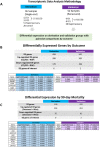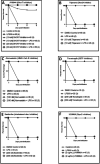This is a preprint.
DHCR7 Expression Predicts Poor Outcomes and Mortality from Sepsis
- PMID: 36778468
- PMCID: PMC9915766
- DOI: 10.21203/rs.3.rs-2500497/v1
DHCR7 Expression Predicts Poor Outcomes and Mortality from Sepsis
Update in
-
DHCR7 Expression Predicts Poor Outcomes and Mortality From Sepsis.Crit Care Explor. 2023 Jun 14;5(6):e0929. doi: 10.1097/CCE.0000000000000929. eCollection 2023 Jun. Crit Care Explor. 2023. PMID: 37332366 Free PMC article.
Abstract
Objective: Sepsis patients experience poor outcomes including chronic critical illness (CCI) or early death (within 14 days). We investigated lipid metabolic gene expression differences by outcome to discover therapeutic targets. Design: Secondary analysis of samples from prospectively enrolled sepsis patients and a zebrafish sepsis model for drug discovery. Setting: Emergency department or ICU at an urban teaching hospital. Patients: Sepsis patients presenting within 24 hours. Methods: Enrollment samples from sepsis patients were analyzed. Clinical data and cholesterol levels were recorded. Leukocytes were processed for RNA sequencing (RNA-seq) and reverse transcriptase polymerase chain reaction (RT-qPCR). A lipopolysaccharide (LPS) zebrafish sepsis model was used for confirmation of human transcriptomic findings and drug discovery. Measurements and Main Results: There were 96 samples in the derivation (76 sepsis, 20 controls) and 52 in the validation cohort (sepsis only). The cholesterol metabolism gene 7-Dehydrocholesterol Reductase ( DHCR7) was significantly upregulated in both derivation and validation cohorts in poor outcome sepsis compared to rapid recovery patients and in 90-day non-survivors (validation only) and validated using RT-qPCR analysis. Our zebrafish sepsis model showed upregulation of dhcr7 and several of the same lipid genes upregulated in poor outcome human sepsis (dhcr24, sqlea, cyp51, msmo1 , ldlra) compared to controls. We then tested six lipid-based drugs in the zebrafish sepsis model. Of these, only the Dhcr7 inhibitor AY9944 completely rescued zebrafish from LPS death in a model with 100% lethality. Conclusions: DHCR7, an important cholesterol metabolism gene, was upregulated in poor outcome sepsis patients warranting external validation. This pathway may serve as a potential therapeutic target to improve sepsis outcomes.
Conflict of interest statement
Competing Interests
The authors have filed a provisional patent for the idea of using
All authors have read Biomed Central’s section on competing interests and have no competing interests to disclose.
References
-
- Singer M, Deutschman CS, Seymour CW, Shankar-Hari M, Annane D, Bauer M, Bellomo R, Bernard GR, Chiche JD, Coopersmith CM, Hotchkiss RS, Levy MM, Marshall JC, Martin GS, Opal SM, Rubenfeld GD, van der Poll T, Vincent JL, Angus DC. The Third International Consensus Definitions for Sepsis and Septic Shock (Sepsis-3). JAMA. 2016. Feb 23;315 (8):801–10. doi: 10.1001/jama.2016.0287. - DOI - PMC - PubMed
-
- Guirgis FW, Brakenridge S, Sutchu S, Khadpe JD, Robinson T, Westenbarger R, Topp ST, Kalynych CJ, Reynolds J, Dodani S, Moore FA, Jones AE. The long-term burden of severe sepsis and septic shock: Sepsis recidivism and organ dysfunction. J Trauma Acute Care Surg. 2016. Sep;81 (3):525–32. doi: 10.1097/TA.0000000000001135. - DOI - PubMed
Publication types
Grants and funding
LinkOut - more resources
Full Text Sources
Miscellaneous





